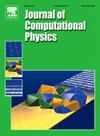Constructing stable, high-order finite-difference operators on point clouds over complex geometries
IF 3.8
2区 物理与天体物理
Q2 COMPUTER SCIENCE, INTERDISCIPLINARY APPLICATIONS
引用次数: 0
Abstract
High-order difference operators with the summation-by-parts (SBP) property can be used to build stable discretizations of hyperbolic conservation laws; however, most high-order SBP operators require a conforming, high-order mesh for the domain of interest. To circumvent this requirement, we present an algorithm for building high-order, diagonal-norm, first-derivative SBP operators on point clouds over level-set geometries. The algorithm is not mesh-free, since it uses a Cartesian cut-cell mesh to define the sparsity pattern of the operators and to provide intermediate quadrature rules; however, the mesh is generated automatically and can be discarded once the SBP operators have been constructed. Using this temporary mesh, we construct local, cell-based SBP difference operators that are assembled into global SBP operators. We identify conditions for the existence of a positive-definite diagonal mass matrix, and we compute the diagonal norm by solving a sparse system of linear inequalities using an interior-point algorithm. We also describe an artificial dissipation operator that complements the first-derivative operators when solving hyperbolic problems, although the dissipation is not required for stability. The numerical results confirm the conditions under which a diagonal norm exists and study the distribution of the norm's entries. In addition, the results verify the accuracy and stability of the point-cloud SBP operators using the linear advection equation.

在复杂几何上的点云上构造稳定的高阶有限差分算子
具有分部求和(SBP)性质的高阶差分算子可用于建立双曲守恒律的稳定离散化;然而,大多数高阶SBP算子需要一个一致的高阶网格来处理感兴趣的域。为了规避这一要求,我们提出了一种算法,用于在水平集几何上的点云上构建高阶,对角范数,一阶导数SBP算子。该算法不是无网格的,因为它使用笛卡尔切割网格来定义算子的稀疏模式并提供中间正交规则;然而,网格是自动生成的,一旦构造了SBP算子,就可以丢弃网格。利用这个临时网格,我们构建了局部的、基于单元的收缩压差分算子,这些差分算子被组装成全局的收缩压算子。我们确定了正定对角质量矩阵存在的条件,并通过使用内点算法求解线性不等式的稀疏系统来计算对角范数。我们还描述了一种人工耗散算子,它在求解双曲型问题时与一阶导数算子互补,尽管稳定性不需要耗散算子。数值结果证实了对角范数存在的条件,并研究了对角范数分量的分布。此外,结果验证了采用线性平流方程的点云SBP算子的准确性和稳定性。
本文章由计算机程序翻译,如有差异,请以英文原文为准。
求助全文
约1分钟内获得全文
求助全文
来源期刊

Journal of Computational Physics
物理-计算机:跨学科应用
CiteScore
7.60
自引率
14.60%
发文量
763
审稿时长
5.8 months
期刊介绍:
Journal of Computational Physics thoroughly treats the computational aspects of physical problems, presenting techniques for the numerical solution of mathematical equations arising in all areas of physics. The journal seeks to emphasize methods that cross disciplinary boundaries.
The Journal of Computational Physics also publishes short notes of 4 pages or less (including figures, tables, and references but excluding title pages). Letters to the Editor commenting on articles already published in this Journal will also be considered. Neither notes nor letters should have an abstract.
 求助内容:
求助内容: 应助结果提醒方式:
应助结果提醒方式:


